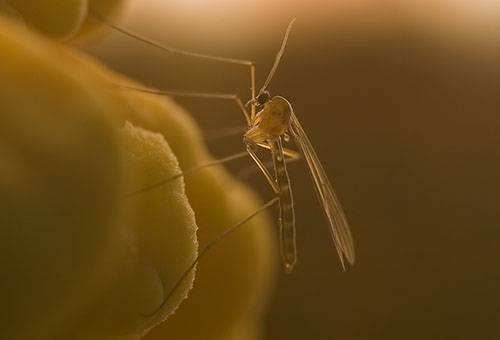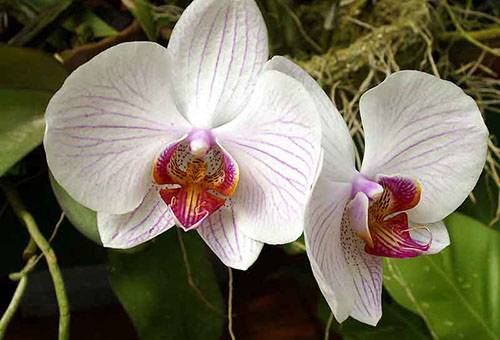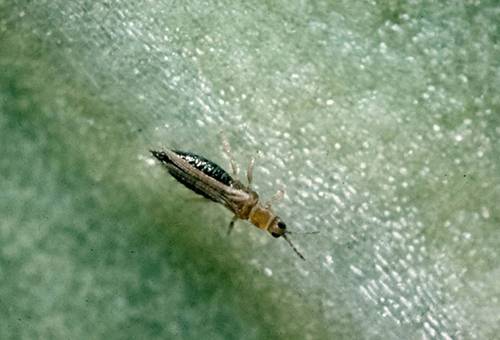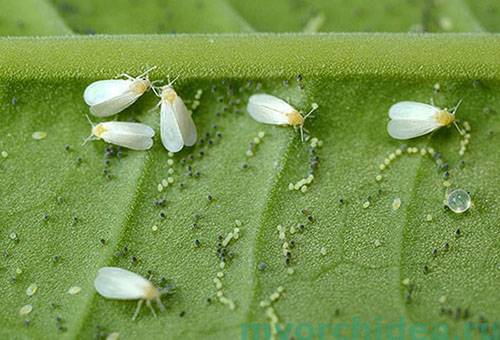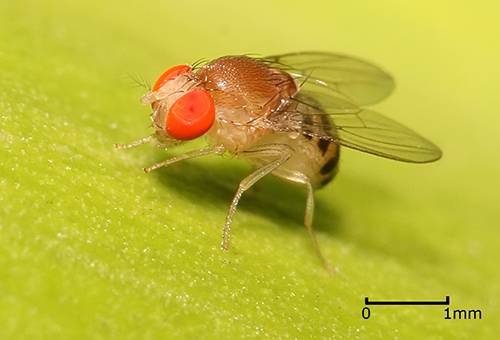How to save orchids from midges?
Several types of pests called midges can be found in orchids. To find out how to get rid of them, you need to try to determine the type. Most often, such types of midges harm orchids:
- sciarides or mushroom mosquitoes;
- thrips;
- whiteflies;
- Drosophila.
Only when your unwanted little "neighbors" are identified, you can choose the way to get rid of them, the most suitable for you and for the plant.
Next, we will examine in more detail each of these types of pests and ways to get rid of them.
Mushroom mosquitoes
Mushroom mosquitoes themselves do not cause much harm to the flower, although they irritate the grower, but the larvae of these insects can destroy the roots of the plant. Therefore, it is better to get rid of them in a timely manner.
How to determine that this is a mushroom mosquito? First of all, check the condition of the leaves - if there are no black dots and a silver film on them, then most likely, scyarides are wound up in your flower. To determine exactly who you are dealing with, look at the appearance of the pest - mushroom mosquitoes often fly over a flower in large numbers.
Most often, sciarides are introduced together with a new substrate. For propagation, they prefer moist soil or a substrate rich in peat or moss. Therefore, it is important to grow the plant in a special substrate for orchids.
Also, midges can be found in the remains of decomposed soil, so it must be changed in a timely manner.
How to fight?
- The most effective method is to capture adults by hand or using a special adhesive tape or plate, preferably yellow. Adults live only a few days, so they are quite simple to breed using this method.
- You can arrange yellow plates next to the plant by filling them with water with a few drops of any dishwashing detergent.
- Plant nearby plants that have sticky leaves, they will cope well with mosquitoes.
- Provide proper watering to the plant - between the irrigations the substrate should completely dry and remain dry for 3 days, in a dry substrate the larvae do not survive.
Tip
Ensure the correct watering regime for orchids and check what composition of the substrate you are using.
Thrips
This type of midge autumn is dangerous for all flowers, so the plant must be isolated from the rest.
Defining thrips infection is quite simple:
- the color of the leaves changes, and they gradually die;
- a silver film appears;
- black dots on the leaves.
Outwardly, thrips are quite easy to identify: these insects have an elongated body shape with two wings.
An orchid can get thrips from another plant, but the effect of low humidity is not ruled out.
The control strategy implies the consistent implementation of the following actions.
- It is necessary to rinse the flower under warm water, which will wash off some of the individuals.
- It is necessary to remove all damaged parts of the leaves.
- Get rid of adults and / or treat the plant with special means. Adult thrips can be caught on sticky tapes / strips not yellow. You can also arrange blue saucers with water. From chemicals, you can use sprays or root sticks for hard-to-reach spots. Sprays are very effective in controlling thrips, but can make photosynthesis of plants difficult due to the sticky structure, so they are very undesirable to use on orchids with thin leaves.
If you do not want to use chemicals, then you can try one of the folk methods.
- It is necessary to make a soap solution consisting of 300 ml of water and 1 tsp. liquid soap.
- Garlic broth - you need to chop 3 cloves of garlic and pour 0.5 liters of boiling water, let it brew for 4 hours and apply on all leaves.
- You can do oil spraying with a solution of 0.5 liters of water and 1 tbsp. l olive or grape oils.
Tip
Try to ensure optimal air humidity and constantly inspect plants to detect infection in a timely manner.
Whiteflies
These are small white midge butterflies that live inside the pot and take off from the plant as soon as you touch it. Most often settle on plants with thin leaves.
Infection comes from other plants. The color on the leaves and stems gradually disappears, then they deform and fall off.
How to get rid of this dangerous pest? It is most effective to process the flower with an appropriate insecticide, but often the insects fly apart, and what to do with them is unclear. So, so that the butterflies do not fly away, you can carefully approach the flower with a vacuum cleaner and, having scared them, quickly collect the flying insects. Then the plant can be washed and treated with a soapy solution.
Fruit flies
They are also called fruit midges, and they are, in general, safe for orchids, but you still need to get rid of them.
If these midges are wound up in a flower pot, then most likely you are watering it excessively or adding tea leaves to the substrate.
Fighting Drosophila is quite simple. You just need to remove the source that attracts them (tea leaves, moss, etc.) and reduce watering.
If you find some flying insect that looks like a midge near your favorite flower, do not think for a long time what to do with it. Do not hesitate to destroy - regardless of whether it is very dangerous for the flower or not. Any insects interfere with the normal life of the plant, and if you get rid of them in a timely manner, your favorite orchid will delight you with its flowering for a long time.
We advise you to read the article: gladiolus
